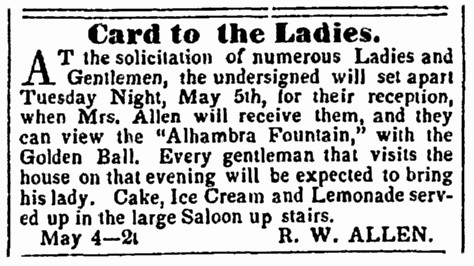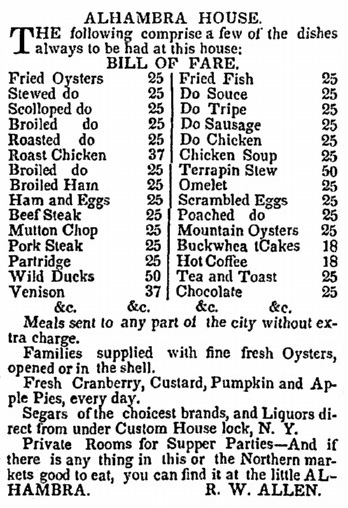 In the 1840s and 1850s, when Russell W. Allen ran restaurants in Richmond VA, newspaper advertising for eating places employed pat phrases such as the one that serves as this post’s title. Allen advertised frequently in the papers and, judging from descriptive blurbs, he attracted affluent men looking for fine liquors and cigars, as well as top quality duck, seafood, oysters, and game.
In the 1840s and 1850s, when Russell W. Allen ran restaurants in Richmond VA, newspaper advertising for eating places employed pat phrases such as the one that serves as this post’s title. Allen advertised frequently in the papers and, judging from descriptive blurbs, he attracted affluent men looking for fine liquors and cigars, as well as top quality duck, seafood, oysters, and game.
In 1843 he opened The Alhambra which, like most eating places then also served as a hotel. His aim was to have the foremost eating place in Richmond.
The son of a Providence RI cabinet maker, Russell was 24 years old in 1835 when he married. He and Agatha moved to Richmond a few years later. In 1840 he was employed as a decorative painter whose business included hand painting custom window shades. Agatha ran a boarding house for Virginia legislators.
Although it was open to the public, it would seem as though Russell’s eating saloon developed as an extension of the boarding house. His first advertisements make a direct appeal to legislators whom he offered three meals a day, promising to have on hand fine oysters from nearby rivers and bays “fresh three times a week.” He also imported live lobsters from the North, a practice which he said was highly unusual since most lobsters in Richmond were brought there pre-cooked. [bill of fare, 1844]
The Alhambra was located on the main thoroughfare, 14th street, near the bridge that crossed the James River. Outside was a sign of a deer visible in the day but eclipsed after dark by the standard candlelit red balloon that identified oyster houses. In 1846 the establishment moved two doors closer to the bridge and installed private dining rooms. A new and sensational feature was a fountain with a statue of a Greek goddess bearing a flowing cup, surrounded by swans. The spouting water held aloft a golden ball.
 After a Richmond newspaper advised that “those who wish to see a pretty fountain should pay one visit at least,” the normally all-male sanctum was besieged by women wanting a peek inside. The result was a ladies’ night advertised in May of 1846 with Agatha Allen on hand to reassure visitors that the goings on would remain cake & lemonade respectable.
After a Richmond newspaper advised that “those who wish to see a pretty fountain should pay one visit at least,” the normally all-male sanctum was besieged by women wanting a peek inside. The result was a ladies’ night advertised in May of 1846 with Agatha Allen on hand to reassure visitors that the goings on would remain cake & lemonade respectable.
Perhaps due to the death of his father in 1848, Russell sold his business in 1849 and the family moved to New York City, where he also ran an eating place. In 1852 he returned to Richmond, bought out the Rough and Ready on the corner of 12th and Main, renamed it The Arbour, and kept it going until 1858. He tried to equal The Alhambra’s reputation as an epicurean eating place, though I can’t tell how well he succeeded. In 1852 he ran an advertisement for quick eats at reduced prices as shown above. It contains something I’ve never seen before, “domestic pie,” which I’m guessing is another way of saying homemade. Also, sora, a marsh bird.
After he gave up the restaurant and hotel business, Russell Allen returned to his earlier career as a painter and earned the rank of Captain in the Civil War.
© Jan Whitaker, 2014
















 It's great to hear from readers and I take time to answer queries. I can't always find what you are looking for, but I do appreciate getting thank yous no matter what the outcome.
It's great to hear from readers and I take time to answer queries. I can't always find what you are looking for, but I do appreciate getting thank yous no matter what the outcome.


